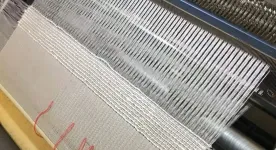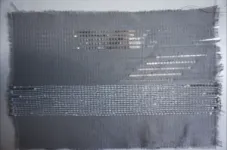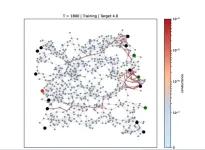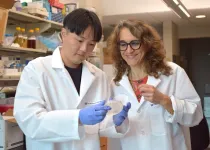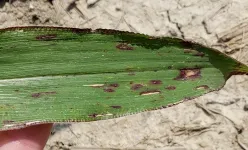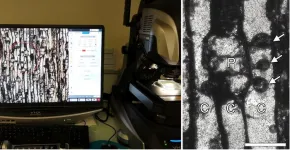(Press-News.org) Researchers have developed next-generation smart textiles – incorporating LEDs, sensors, energy harvesting, and storage – that can be produced inexpensively, in any shape or size, using the same machines used to make the clothing we wear every day.
The international team, led by the University of Cambridge, have previously demonstrated that woven displays can be made at large sizes, but these earlier examples were made using specialised manual laboratory equipment. Other smart textiles can be manufactured in specialised microelectronic fabrication facilities, but these are highly expensive and produce large volumes of waste.
However, the team found that flexible displays and smart fabrics can be made much more cheaply, and more sustainably, by weaving electronic, optoelectronic, sensing and energy fibre components on the same industrial looms used to make conventional textiles. Their results, reported in the journal Science Advances, demonstrate how smart textiles could be an alternative to larger electronics in sectors including automotive, electronics, fashion and construction.
Despite recent progress in the development of smart textiles, their functionality, dimensions and shapes have been limited by current manufacturing processes.
“We could make these textiles in specialised microelectronics facilities, but these require billions of pounds of investment,” said Dr Sanghyo Lee from Cambridge’s Department of Engineering, the paper’s first author. “In addition, manufacturing smart textiles in this way is highly limited, since everything has to be made on the same rigid wafers used to make integrated circuits, so the maximum size we can get is about 30 centimetres in diameter.”
“Smart textiles have also been limited by their lack of practicality,” said Dr Luigi Occhipinti, also from the Department of Engineering, who co-led the research. “You think of the sort of bending, stretching and folding that normal fabrics have to withstand, and it’s been a challenge to incorporate that same durability into smart textiles.”
Last year, some of the same researchers showed that if the fibres used in smart textiles were coated with materials that can withstand stretching, they could be compatible with conventional weaving processes. Using this technique, they produced a 46-inch woven demonstrator display.
Now, the researchers have shown that smart textiles can be made using automated processes, with no limits on their size or shape. Multiple types of fibre devices, including energy storage devices, light-emitting diodes, and transistors were fabricated, encapsulated, and mixed with conventional fibres, either synthetic or natural, to build smart textiles by automated weaving. The fibre devices were interconnected by an automated laser welding method with electrically conductive adhesive.
The processes were all optimised to minimise damage to the electronic components, which in turn made the smart textiles durable enough to withstand the stretching of an industrial weaving machine. The encapsulation method was developed to consider the functionality of the fibre devices, and the mechanical force and thermal energy were investigated systematically to achieve the automated weaving and laser-based interconnection, respectively.
The research team, working in partnership with textile manufacturers, were able to produce test patches of smart textiles of roughly 50x50 centimetres, although this can be scaled up to larger dimensions and produced in large volumes.
“These companies have well-established manufacturing lines with high throughput fibre extruders and large weaving machines that can weave a metre square of textiles automatically,” said Lee. “So when we introduce the smart fibres to the process, the result is basically an electronic system that is manufactured exactly the same way other textiles are manufactured.”
The researchers say it could be possible for large, flexible displays and monitors to be made on industrial looms, rather than in specialised electronics manufacturing facilities, which would make them far cheaper to produce. Further optimisation of the process is needed, however.
“The flexibility of these textiles is absolutely amazing,” said Occhipinti. “Not just in terms of their mechanical flexibility, but the flexibility of the approach, and to deploy sustainable and eco-friendly electronics manufacturing platforms that contribute to the reduction of carbon emissions and enable real applications of smart textiles in buildings, car interiors and clothing. Our approach is quite unique in that way.”
The research was supported in part by the European Union and UK Research and Innovation.
END
Cheaper method for making woven displays and smart fabrics – of any size or shape
2023-04-21
ELSE PRESS RELEASES FROM THIS DATE:
Researchers devise cascaded microfluidic circuits for pulsatile filtration of extracellular vesicles directly from whole blood samples
2023-04-21
Extracellular vesicles (EVs) are cell-secreted lipid bilayer bioparticles with a diameter of 30 to 250 nm. They are a promising source of biomarkers for liquid biopsies for early cancer diagnosis and real-time monitoring of tumor development. However, analysis of nanosized EVs in blood samples has been hampered by the lack of effective, rapid, and standardized methods to isolate and purify EVs.
In a study published in Science Advances, SUN Jiashu’s group from the National Center for Nanoscience and Technology (NCNST) of the Chinese Academy of Sciences (CAS) and collaborators from the Fifth Medical Center of the Chinese PLA General ...
Nanowire networks learn and remember like a human brain
2023-04-21
An international team led by scientists at the University of Sydney has demonstrated nanowire networks can exhibit both short- and long-term memory like the human brain.
The research has been published today in the journal Science Advances, led by Dr Alon Loeffler, who received his PhD in the School of Physics, with collaborators in Japan.
“In this research we found higher-order cognitive function, which we normally associate with the human brain, can be emulated in non-biological hardware,” Dr Loeffler said.
“This work builds on our previous research in which we showed how nanotechnology could be used to build a brain-inspired electrical device with neural ...
Long distance voyaging among the Pacific Islands
2023-04-21
Polynesian peoples are renowned for their advanced sailing technology and for reaching the most remote islands on the planet centuries before the Europeans reached the Americas. Through swift eastward migrations that are now well covered by archaeological research, Polynesian societies settled virtually every island from Samoa and Tonga to Rapa Nui/Easter Island in the east, Hawai’i in the north, and Aotearoa/New Zealand in the south. But little is known about Polynesian migrations west of the 180th meridian.
In order to better understand the relationship between these Polynesian societies of the western Pacific, Melanesia and Micronesia – often ...
Heart injury biomarker may help COVID-19 patients avoid hospitalization, new study shows
2023-04-21
A study led by the University of St Andrews suggests that a frequently used medical test for heart injury could one day be used to help COVID-19 patients avoid hospitalisation.
Cardiac troponins are proteins that form part of the heart’s contractile machinery and are released into the bloodstream when the heart is damaged. It can be measured in a blood test which is widely used in the assessment of heart attacks and other heart conditions.
Existing studies since 2020 have shown that COVID-19 patients who have elevated troponin levels are more likely to die or suffer adverse clinical outcomes compared with those who have normal ...
Study: Cells send maintenance crews to fix damaged protein factories
2023-04-21
JUPITER, Fla. — In a discovery fundamental to the inner workings of cells, scientists have discovered that if oxidative stress damages protein factories called ribosomes, repair crews may move in to help fix the damage so work can quickly resume.
The discovery, reported Friday in the journal Molecular Cell, could have implications for cancer, the aging process, and growth and development, said the study’s lead author, molecular biologist Katrin Karbstein, Ph.D., a professor at The Herbert ...
New stellar danger to planets identified by NASA'S Chandra program
2023-04-21
CHAMPAIGN, Ill. — An exploded star can pose more risks to nearby planets than previously thought, according to a new study from NASA’s Chandra X-ray Observatory and other X-ray telescopes. This newly identified threat involves a phase of intense X-rays that can damage the atmospheres of planets up to 160 light-years away.
The results of the study, led by researchers at the University of Illinois Urbana-Champaign, Washburn University and the University of Kansas, are published in the Astrophysical Journal.
Earth is not in danger of such a threat today because there are no potential supernova progenitors within this distance, but it may have experienced ...
Why are COVID-19 vaccination rates among children so low? Parents’ worry about long-term risks, responsibility
2023-04-21
Despite efforts by the U.S. Centers for Disease Control and Prevention and pediatric clinicians to increase the COVID-19 vaccination rate among children, many remain unvaccinated due to parental concerns about the vaccine’s long-term effects and anticipated responsibility. Those are findings from a new study published in Pediatricsand conducted by the Center for Economic and Social Research(CESR) at the USC Dornsife College of Letters, Arts and Sciences.
The researchers sought to determine the causes of low child vaccination rates. Currently, only 39% of children 5 to 11 and 68% of those 12 to 17 have received ...
Insignum AgTech and Beck’s collaborate to help corn ‘talk’
2023-04-21
ATLANTA, Ind. – Insignum AgTech® and Beck’s have signed an agreement to test Insignum’s innovative corn traits in Beck’s elite varieties. The companies will collaborate to cross the trait into proprietary Beck’s genetics for field-testing in 2023 to evaluate commercial viability of the traits.
Insignum AgTech develops plant genetic traits that enable plants to “talk” and signal to farmers when specific plant stresses begin.
“With this trait, a corn plant generates purple pigment, indicating that a fungal infection has started ...
New study uncovers Colorado’s spicy ancient history of chili peppers
2023-04-21
Botanists and paleontologists, led by researchers from the University of Colorado Boulder, have identified a fossil chili pepper that may rewrite the geography and evolutionary timeline of the tomato plant family.
The team’s findings, published last month in the journal New Phytologist, show that the chili pepper tribe (Capsiceae) within the tomato, or nightshade (Solanaceae), family is much older and was much more widespread than previously thought. Scientists previously believed that chili peppers evolved in South America at most ...
360-million-year-old Irish fossil provides oldest evidence of plant self-defense in wood
2023-04-21
An international team of scientists, co-led by Dr Carla J. Harper, Assistant Professor in Botany in the School of Natural Sciences at Trinity, has discovered the oldest evidence of plant self-defence in wood in a 360-million-year-old fossil from south-eastern Ireland.
Plants can protect their wood from infection and water loss by forming special structures called “tyloses”. These prevent bacterial and fungal pathogens from getting into the heartwood of living trees and damaging it. However, it was not previously known how early in the evolution of plants woody species became capable of forming such defences.
Published ...
